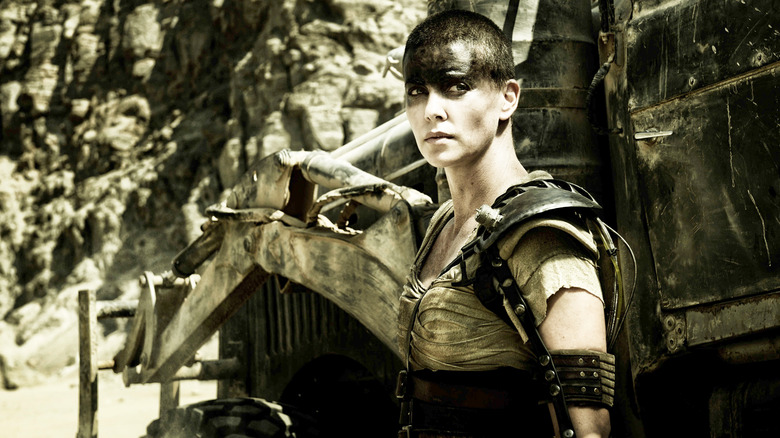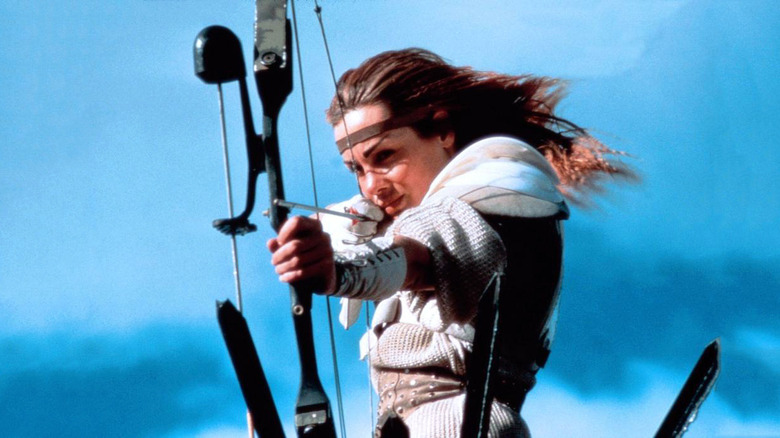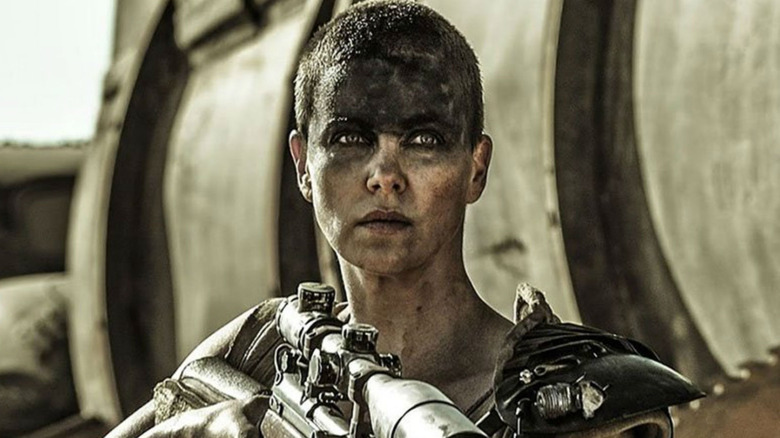Furiosa's Roots Can Be Traced All The Way Back To Mad Max 2
When "Mad Max: Fury Road" was released in 2015, critics and fans alike marveled at the inclusion (not to mention the prominence) of the character of Furiosa. As played by Charlize Theron, Imperator Furiosa is one of the most well-rounded female characters in all of genre cinema: strong but not invulnerable, attractive but not sexualized, complex and flawed while being innately heroic. She is, in essence, the "Mad Max" series' female answer to Max Rockatansky, a survivor within a dangerous world gone insane, a character who must balance their hunger for revenge with their internal sense of altruism.
While Furiosa being such an integral part of "Fury Road" led many to speculate that the character was director and co-writer George Miller's metatextual response to his male-centric "Mad Max" franchise and action films in general, the roots of the character stretch back further than just "Fury Road." In fact, similar female warrior characters can be seen in both 1981's "Mad Max 2" (known in America as "The Road Warrior") and 1985's "Mad Max Beyond Thunderdome," proving that the franchise, as well as Miller himself, had much in mind for the women of the film series.
The Road Warrior meets the Warrior Women
While Max (played by Mel Gibson) had a resilient yet doomed wife played by Joanne Samuel in 1979's "Mad Max," it was the otherwise unnamed Warrior Woman played by Virginia Hey in "Mad Max 2" that established a standard for the series' female characters. One of the guardians of a band of survivors who fights bravely and takes no guff from the prickly Max, and ultimately comes to have a mutual respect for the nomadic warrior, the character was encouraged to grow by George Miller through empowering Hey. As the actress recalled, "in those days [Miller] was fairly minimal" with his direction, and wanted Hey "to find [the character] within me and not portray his interpretation of who I should be." Thus, Hey's Warrior Woman became a notable female hero figure in the film, refusing to be reduced to a victim or sidekick role.
That trend continued with the next movie in the series, "Mad Max Beyond Thunderdome." In that film, not only is there a strong female heroine, Savannah Nix (Helen Buday), who is the leader of a tribe of survivor children, but the movie's most prominent villain is a woman. As played by Tina Turner, Aunty Entity is the leader of a community known as Bartertown, a position she holds onto with a combination of ruthlessness and cunning. While she's far from a role model, the iconic character is written and portrayed with much more nuance and sympathy than the series' other villains (all of whom happen to be men). The Toecutter (Hugh Keays-Byrne), The Humungus (Kjell Nilsson), and Immortan Joe (also Keays-Byrne) are all monsters who come to grisly ends, but Aunty Entity is afforded a chance at redemption, much like Furiosa.
Furiosa lives historic on the Fury Road
When George Miller was writing "Mad Max: Fury Road" with co-writers Brendan McCarthy and Nico Lathouris, he drew upon the prior films for inspiration, finding himself particularly taken with the idea of a female character in the wasteland. Recalling Virginia Hey's Warrior Woman in "Mad Max 2," Miller told Vulture he "always wondered about a character like that. How does a female survive in a much more elemental world?" Concluding that "It's not just by aping a man" and that such a character "had to be an authentic road warrior," Miller and his collaborators came up with the idea for Imperator Furiosa, the driver of Joe's War Rig who chooses to betray her diseased fascist overlord and liberate his captive "wives."
Echoing his creative process years earlier with Hey, Miller let Charlize Theron define the character of Furiosa fully. He realized that the actress was on the same page as himself with regards to Furiosa's authenticity, recalling that "Charlize really picked up on that early" and went about preparing herself as if she had to survive for real in a wasteland: shaving her head, having skill with vehicles and weapons, and having strength. In retrospect, Miller acknowledged that such a character "felt like a corrective" and yet "everything rose organically out of the story."
Looking at the "Mad Max" series as a whole, one could say that the character of Furiosa emerged organically from the franchise. The seeds of the character were always there, and as a result, Furiosa not only feels like a natural extension of the film series but acts as arguably its strongest character to date. With a prequel film centering on the character about to go into production, it's clear that the adventures of Furiosa are just beginning.


